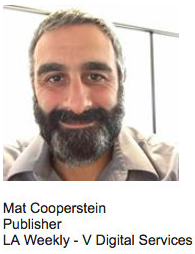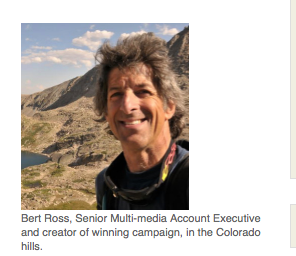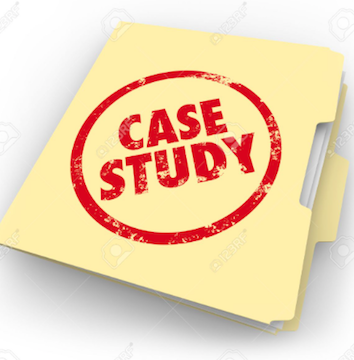Customers, not your platform, create your success
Case studies are the #2 most influential type of information used by executives making a technology purchase – just after product demos. We picked up these pointers from LocalMediaInsider´s case study-based trade journal, which existed for five years solely on subscriptions to valuable case study content.
According to LocalMediaInsider´s editor, the entire point of a great case study should be to capture what a top customer is doing right, in real life, after the purchase. Not only is this information worth the time and money of other top executives, it also recognizes your best customers and turns them into advocates.
So what goes into a great case study, besides utilizing the “challenge, strategy, results” model? Here are some tips:
1. Do tell a story
Don’t worry about showcasing features of the platform or service. This story is about your customer and how they overcame a challenge on the road to success.
Business case studies need both just enough detail to engage a reader and key statistics that prove the case to an analytical thinker.
2. Do use the third person voice
This is not the time to to write in the generic company “we,” as in “we did this and that for the client.”
It is the customer’s story, so using first person or second person is distracting. Stick with “she, he and they.”
3. Be educational
Business readers use case studies to learn, so case studies that do not convey specific tactics the client used to create success miss an opportunity.
In the worst case, a case study gives the “pain point,” mentions the platform/service and skips to results.
These are not only useless as a source of “real world” strategy, but also less convincing to prospects.
In the best cases, an educational approach builds confidence in your company, and lets prospect know they will have access to training.
One example is a set of end-user case studies TechRefs has been building for Adcellerant, a platform that provides backend agency services.
A typical case study in the set is one for end-user Geffen Playhouse. It describes the type of targeting (microproxity in this case), who supplied the addresses utilized, why those were selected, and other aspects of the multi-media campaign.
This type of information can be used for customer training on verticals, as well as to show competitive differentiators for the platform, and to prove results.
5. Do identify exceptional clients
Remember Lance Armstrong’s book, “It’s not about the bike”? Cheating aside, he had a point. As we noted above, in the case of SaaS, it is ultimately the customers, not platform, that creates your success.
Put another way, at least half of the success comes from what customer is doing with technology: It is their strategy and engagement that tells the story.
So…. make a list of your most successful clients, but start with the smartest ones.
6. Make it a win/win for the customer by recognizing their thought leadership and execution strategies
The complaint we hear most from technology companies is that even though they have the data on their most successful customers, they are not able to get the customers’ permission to use it.
Sometimes the CEO is pushing for better case studies, but the marketing department cannot deliver – and too often it is not their fault.
Only the CEO can decide whether a technology company will act like a vendor or a strategic partner, and commit to the deeper level of engagement required.
So how do you get customers to talk about their successes?
One way is to engage awards programs that add to company and professional credentials. help them expand their own professional network, and facilitate sharing of best practices.
It helps to utilize a third party like TechRefs or LocalMediaInsider who use professional journalists. However, some companies, such as SecondStreet Media, a hugely successful company in the cut-throat world of deals and contesting, have built entire resource centers using the case study model.
SecondStreet Media creates a variety of their own ongoing customer recognition programs such “Top 30” deals or “Top Ten contests for fall” shared with customers from around the country.
These case studies are recategorized by product and vertical for use as a training resource and have become a major differentiator for SecondStreet as an SaaS platform.
Some ‘winners’ actually write their own best practice case studies, a cool trick when you consider how many companies say they cannot get permission for “real” case studies at all.
SecondStreet also hosts customer events to facilitate peer sharing, and is invited to speak at customer conferences – not about their success, but about customer best-practices.
Another savvy platform company, iPublish Media, holds webinars and speaking events where their most successful media customers are invited to talk about how they did it and/or share new ideas. The most popular ones also go into the development queue.
If that sounds like s stretch, partnering with external awards is another method. To create end-user case studies for AdCellerant, LocalMediaInsider partnered with them to nominate excellent client work in Top Ad Awards, which recognizes excellence in local digital advertising.
Winners received a subscription and invitation to the virtual awards banquet. The program generated AdCellerant’s first ten case studies using real clients and results for the first time.
8. The first part of the case study: The challenge
To build a great story, start by using just enough information about the background of the company for the reader to engage. How old is it? Where is it? Who is the key executive? What was the challenge?
Yes, this can and should be short, but a few key details make the company “real” to the reader. It doesn’t have to take more than a couple of sentences:
Denver-based media customer, Westword, was trying to resurrect a dormant account, Sportique, a store that sells urban scooters.
Westword’s sales representative persuaded the store to give it another try for their first ever “blow out sale” intended to clear floor inventory for new models.
Hooked yet? Find out what happened here.
9. Don’t scrimp on the strategy and tactics section
As mentioned above, the strategy area of the case study is where other executives learn but finding specific tactics.
Here’s the beginning of the strategy in the Geffen Playhouse case study:
“The LA Weekly supplied the addresses of 766 live, ticketed venues, using its programmatic partner, accelerant, to “map” the campaign to the addresses, reaching people on their phones and devices while they attended events. The campaign ran for five weeks prior to and during the show.
Device retargeting “picks up” device information for anyone logged in on a device and retargets them for another 30 days. “
The case study went on to show how The LA Weekly supplied an email component, online ads on their own website and even a drag queen in the lobby for the opening night.
For more multifaceted strategies, use bullet points, screenshots and other visual examples. The more cases studies with this kind of valuable information, the better set your company will be to begin offering Best Practices webinars.
10. Begin with the end in mind: Results
Results are so important that they make powerful headlines. Here’s one TechRefs wrote for the Sportique campaign mentioned above: “Sportique’s programmatic campaign increases YOY sales by 40%”
Take some time to find the most powerful statistics or other factors in the results. “Sales increased by 3000%” sounds better than “Sales increased by $3000.”
What is tracked may not be revenues; it could be the number of inquiries (clicks), conversions, cost savings, time savings, end-users gained, or just that the customer was saved and renewed for five more years.
In the case of the Geffen Playhouse case study, the media and the theater company had agreed that anyone who stayed on the site 30 seconds or longer was likely to be buying a ticket.
Here are the stated results: “274,000 impressions generated a .23 Click Through Rate (CTR) for about 621 click-throughs and 241 ‘conversions’ ie people who stayed on the site 30 seconds or longer.
“Of the conversions, 78% clicked on the ads in real time and 22% came back after the fact, during the retargeting phase.”
Additional information is more qualitative:
“’It is a really strong audience, sitting in the venue waiting for the show to start or during intermission,’ Cooperstein said. This data now belongs both to V Digital and Geffen, who can retarget these same people at a future date.”
11. Yes, this takes a phone call
Sending questions in advance often helps, but a phone interview is a necessity for follow-up questions. Otherwise, the case study tends to be dry and incomplete. There are a variety of ways to present information, ie rather than referring to earning $3000, the program result could be a more exciting 300%. Questions can solicit this extra information.
If a content writer is using email questionnaire only, it’s time to find a journalist.
12. Add an image and some background on the customer
Once you start adding images of the people recognized by awards programs, you will never look back.
Not only does the image of the client add life to the case study, but it underscores that this is the work of a real person, and helps people who have shared information to build their professional network. Here are a couple of actual human being at the top of their field, contributing expertise:


Yes, humans, not technology, do these things.
13. Send the case study to the client for approval
The best way to avoid any problems down the line, either from mistakes or anything else that might crop up, is to send the case study back to the client.
In our experience only about two in ten case studies have minor changes and about one in 30 is “killed” by a company higher-up determined to control information.
However, it is always better to lose a case study than to break a trust. One tip for a higher rate of approval is to be assumptive, rather than waiting on the client. Giving a deadline, “please let me know by Friday, our publication date, if there is anything here that is inaccurately worded,” will avoid losing all the work on the case study for a client who stops responding for whatever reason.
14. Acquire a referral/testimonial but be 100% transparent
As long as the client is on the phone and sharing information, the interviewer might as well attempt to a reference, usable testimonial or both.
The most transparent practice is to always notify the interviewee, even by a follow-up email, “Hey, we’d like to post this quote on the (vendor) website next week. Please let me know if you have any objections.”
Work harder to get an actual confirmation on the use of a quote if the case study is not widely published. There’s nothing that breaks trust faster than being surprised by seeing your own words turned into an unintentional online testimonial.









